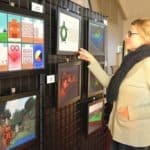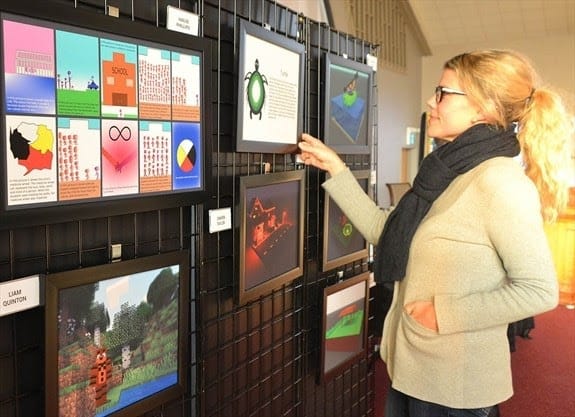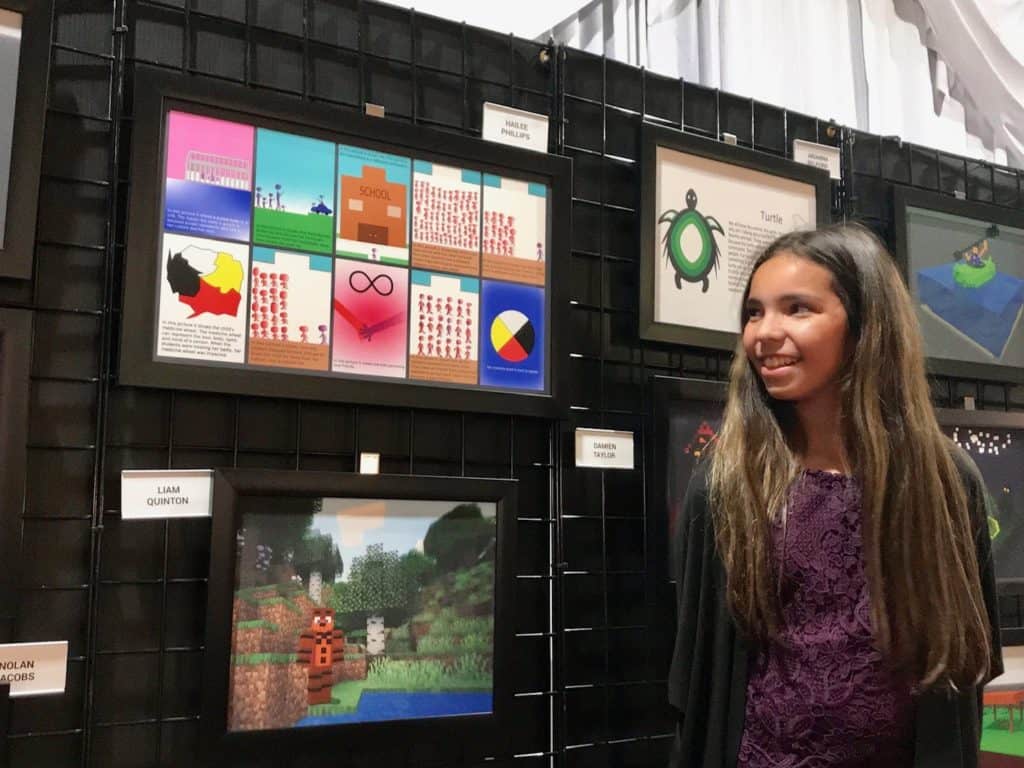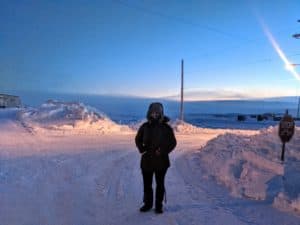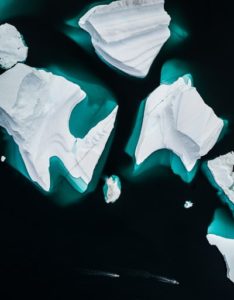During the last two weeks of August, Pinnguaq staff and volunteers had the pleasure to work with 28 youth members of Curve Lake First Nation in Ontario. The camp facilitated the exploration of storytelling and the creation of digital artworks around the stories that the participants developed. By the end of the two weeks, the students completed new media artworks to be exhibited in different regional galleries.
The aim of the camp was to deliver an arts-based digital literacy initiative that enables youth to connect with cultural and artistic leaders and knowledge keepers to create unique digital art pieces portraying their own stories.
The camp was funded by the Ontario Trillium Foundation and was a partnership between Curve Lake First Nation, Pinnguaq and the Lindsay Art Gallery.
An Art of Storytelling
During the first week of the camp the students, who range in age between 8 and 14, were challenged to examine the nature of story development.
Each day started with a sharing circle for everyone to get to know each other and share their stories and perspectives. The sharing circle also included visits from elders and local storytellers who told legends, lessons, and stories about their lives. This included things as simple as how they were feeling that day to challenges they had faced in the past. This is essential to ensuring that everyone feels like they are not alone because creative work is very isolating and it’s very easy to be discouraged when struggling with learning new tools.
The students were then asked questions. What makes a story good or fun? What’s your favourite story that you’ve heard and why? What were the themes and qualities of the story, and how did the story reveal a sense of change or progression?
The mentors used various activities, such as chain storytelling, to help the students explore these questions and others. These activities were designed to challenge any fears regarding thinking creatively or speaking aloud. Over the course of the week, students were tasked with developing their own stories, both as a group and individually. They were then asked to examine what they had created. “Write a short narrative (1-2 minutes). Start in point form. Organize into beginning-middle-end. Write out as a paragraph. Practice reading it outloud to a partner/group. Be brave, make mistakes, power through.”
The end goal of the story development activities was to encourage the students to write a story which they could then record, edit, and present as either a standalone or accompanying piece to their artwork.
Sounds
Sounds played an important role in the production of their pieces. The participants recorded their stories every day, working with a variety of open-source audio software and recording devices. By the end of the first week each participant was equipped with the basic skills they needed to independently write and record their narrative, and to mix it together with sound effects collected from the field.
Use of a MIDI sequencer allowed students to capture sounds, such as traditional Ojibwe drums and nature sounds from their community, and create soundboards which they could then use to generate music and soundscapes. Representative members of the community were consulted regarding which sounds may be appropriate for such a project, as certain instruments are considered too sacred to be recorded. Traditional beats or songs are generally not to be recorded, however, crafting new beats using traditional instruments was allowed. Drums and shakers were used to accompany some of the final artworks.
“I liked learning how to draw on the computer. I really liked that you can do audio and sound on the computer, and use mics to pick up different sounds. I also liked using MuLab to make beats and stuff.” – Arianna Nedham-Velford, 11
Sounds from Nature
Mobile field recorders were introduced on the first day, and basic functions, connecting the device to the computer and using different microphone filters were covered. Once the participants were comfortable with the field recorders, they went for a walk down to the lake to record some sounds. This activity was well-received and the participants seemed to gain a better understanding of how the outdoors could be incorporated into the primarily indoor activity of working on a computer.
Technology
Along with the story development component, students spent portions of each day learning various digital applications to expand on their story and image concepts.
For the audio portion of the sessions, students were asked to record and edit their stories using the software Audacity. The group initially used the built-in microphones on their laptops to capture audio, before editing it in Audacity. Subsequent lessons covered the use of the field recorder, different microphone filters, actual field recording to capture sounds in nature, as well as MIDI sequencing in Reaper and MuLab.
For the visual part of their installations, students were tutored in the concepts of pixel, voxel and vector art. Exploring digital art creation software in GraphicsGale, MagicaVoxel and Inkscape.
The participants began by working on 16 x 16px and 32 x 32px images with a limited palette of colours, to better understand core pixel art principles. They then moved to animation workflow in GraphicsGale and became comfortable with creating images and animation on their own.
Voxel art instruction flows naturally from pixel art so the core concepts were already understood by most of the students by day two. Working with MagicaVoxel, students learned to create 3D objects and scenes by navigating X/Y/Z axes and placing, removing, and colouring voxels (volumetric pixels). Further enhancement of their images was made by learning to apply material properties to the voxels, to make them appear like metal, glass, plastic, or even emit light. This was by far the most popular portion of the artwork instruction and the majority of students ended up producing final artwork using MagicaVoxel.
“I liked it because I got to do stuff that I never would have been able to without coming here. I got to learn a new app – MagicaVoxel – it was fun!” – Dakota Knott, 10
The participants also learned vector art with Inkscape, where images are created through mathematical expressions rather than with pixel-based raster images. In Inkscape they learned to work with bezier curves, edit and manipulate nodes, and dealt with layers and drawing order.
“I really liked it. I learned a lot of stuff about computers that I wouldn’t have learned if I had stayed at home. I liked how we got to draw our own thing instead of copying other art, and I really like InkScape.” – Hailee Phillips, 12
Results
While the intent of this grant seemed to be focused on producing “traditional” cultural stories and art, the emphasis shifted to focus on the community’s stories and art – narratives and images that best represented the participants’ experiences and relationships to the place they live. Jack Hogarth, the local coordinator, was happy to share ideas about the roles of clans in the community, which provided a nice framework for the kinds of stories to tell. Aspects of the clans, like those found in the seven teachings, provided a solid starting point for the students to draw inspiration for the theme of a story or image, rather than borrowing or retelling a story from traditional narratives.
Many participants created work focusing on the lake or water, others produced works about the wisdom of the turtle, some adapted the story of the spirit of the Wendigo, and one student wrote and illustrated a story about the experience of trying to integrate with a new culture as an outsider. Providing participants with the freedom to choose a story that resonated with them was essential to exploring the actual culture of a community and avoided creating a token version of it.
One participant chose to tell a whimsical story about jellyfish being separated from their collective in the ocean and becoming stuck in a pond. While possibly unaware of the symbolism in that story, encouraging her to pursue something light-hearted and whimsical allowed for a wonderfully poignant story to develop.
Mock Gallery Showing
On the final day of the session the students presented a mock gallery showing at the Curve Lake Cultural Centre. As instructors helped the participants set up their work for display, family and community members were invited for the showing and a barbecue. The exhibit saw an excellent turnout- feedback from both parents and participants was extremely positive.
“I really liked how there’s a lot of friends and cousins here. I liked working on computers and learning how to draw, and I’m looking forward to using these apps in the future.“ -Damien Taylor, 11
Parents of the students expressed positive feelings about the camp and suggested that it be a recurring event. They were happy to see their children connecting with extra-curricular activities particularly in the area of game design and storytelling. Some parents expressed that the camp bridged a gap as these are not skills that the kids were receiving in their local schools and requested resources for continual digital skills learning throughout the school year. Find online digital skills resources on the Learning section of our website.
The Exhibtions
Kawartha Art Gallery will be presenting the media artworks of the Curve Lake First Nations youth at the Gallery from October 15 to November 23, 2019 with an opening reception on Friday, October 18, 2019.
“We view technology as a set of tools that can be used to harness creativity and innovation as well as prepare youth for the future,” said Jennie Cross, director of curriculum development with Pinnguaq. “It’s also an opportunity for more people to tell their stories in a way that is unique to them.”
In late January 2020 the students presented their work again at Curve Lake in a formal exhibition.
Conclusion
This camp was a huge success. The stories and art the participants produced were phenomenal and unexpectedly sophisticated. The parents were overjoyed, and the participants were universally grateful for the experience.
This project is proposed under the Inspired People action area, and is aligned with the grant result of preserving and animating cultural heritage. The goal of this proposal is to enable youth to engage with Anishnaabe cultural heritage and language while gaining essential digital skills and using new media to create and display artwork that contributes to the discourse on Indigenous cultural representation.
As a whole, we aim to foster digital art practices to change the relationship with technology from consumption to creation, and to increase the capacity for youth to actively engage, interact and represent their culture in contemporary ways.
